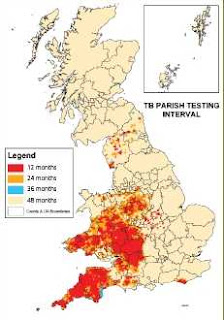.jpg) Some reactions - predictably polarised - to Sir. David King's peer review of the ISG final report, in which he used quite un-scientific, but eloquently cutting phrases to describe the report's unequivocal findings.
Some reactions - predictably polarised - to Sir. David King's peer review of the ISG final report, in which he used quite un-scientific, but eloquently cutting phrases to describe the report's unequivocal findings. "the data do not support such an unqualified conclusion..."A comment on a posting below quoted Animal Aid's predictable hype, which cited "overcrowded factory farms, dirty conditions" - conveniently forgetting 'Shambo' - and The Guardian has John Bourne as defending 'hero' and Sir. David as 'villain', in a short overview of the theatre that is EFRAcom.
"the ISG's view...is unsound..."
"the confidence intervals are very large..."
"it was unclear whether it had been considered..."
"we are concerned about the time frame..."
"this time lag does not seem to have been taken into account..."
"the results...should be viewed with extreme caution..."
"we were not fully persuaded by it..."
"we have concerns about the biological plausibility of the ISG's interpretation of the results..."
The government chief scientist's recommendations to ministers on badger culling were "hastily written", "superficial" and "selective" according to the scientist who led the government's study into the problem of cattle TB.However, it is quite apparent from ploughing through the dough of this Final Report, that much is based on 'assumption', 'rough' estimates and 'hypothoses'. And those can be skewed. And according the the person who framed its methodology, Professor Bourne, it was politically skewed from its outset.
As we have said before, the main tranche of its conclusions on the relative importance of cattle or badgers in the 'net reproduction rate of the epidemic' are summed up in para 7.24 where the ISG describe how they come to the conclusion that badgers account for 40 per cent of incidents. It is a 'tentative' prediction, they say:
...all sources of infection for cattle, local infection for example across farm boundaries, infection from animals bought in particular(ly) but not only, from high incidence areas, and infection from wildlife, especially badgers. All these are important but their relative importance, and that of cattle-to-badger transmission, cannot be estimated directly. In the following calculations, we assume all three sources to be roughly equally important"And that lazy, contradictory (see more in our comment below) 'tentative' prediction, based on 2 parts cattle to 1 part badger, extruded through a 'simple mathematical model' in three 'roughly equal' sound bites are what the final report boils down to. That and John Bourne's infamous 'edges', which Sir David at least was at pains to reinterpret.
Sir David defended his corner well, reminding his audience that his remit was not to offer solutions but to examine the evidence for the ISG's conclusions. He also reminded them that it was his group who brought up sharp the government scientists exploring for three long and expensive years, the possibility of BSE in sheep - by examining cattle brains.
And from the Veterinary Association for Wildlife Management (VAWM) comes the following:
The recent statement by the chief scientist Sir David King that badgers will have to be culled in order to control bovine tuberculosis is a welcome breath of scientific fresh air and common sense to be contrasted with the politically compromised recommendations of the so called Independent Scientific Group earlier this year.They also point out that as control of bTb in wildlife reservoirs has been abandoned for the last ten years, after its progressive sanitation in the previous decade, its spread has effectively been allowed to "run out of control".
VAWM's response to the ISG final report and their statement on Sir. David King's response can be read here, and the farming press comments here and here.










